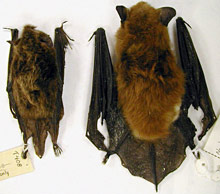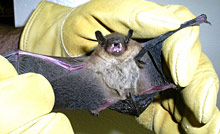- HOME
- » PEST SOLUTIONS
- » Bats
Bats
How to Deal with Bats
 |
|
Little (left) and big (right) brown bats. |
 |
|
Mexican free-tailed bat. |
Bats are good to have around. Putting up bat boxes on your property will give them a place to hang besides your attic. But if bats are in your belfry, call a professional. They'll work with you to close up crevices and holes that let bats in. Closing up all holes in summer could trap baby bats inside—best to wait till late fall, when they've all moved out on their own.
What they look like
Batman got it right—you're most likely to see bat silhouettes in the sky at dawn and dusk. Most bats in the Northeast are brown with 9–12 inch wingspans and bodies 3–5 inches long. (A bat folded up at rest, hanging from its toes, looks surprisingly small, though.) Got lots in your attic? Note their poop, a.k.a. guano, which piles up beneath their hang-out spots.
Where they live
Bats like to have a few options. During summer days they hide in your attic or behind your shutters. Bats can get through crevices as small as ¼" wide by 1 ½" long or holes ½" by ½". At night they're mainly on the wing and hunting, but now and then they relax a bit under your porch or breezeway. In winter they hibernate, usually migrating to a cave, mine, or rock crevice.
What they do
Bats do lots of good, eating kazillions of mosquitoes and other insects. Their guano can grow mold, though—not good to breathe. If a resident finds a bat in their home, it's probably as shocked as they are—sometimes the young get lost when learning to fly in late summer. If a bat gets trapped in a room or you find it on the ground, call a professional wildlife control officer—you want to be cautious about the potential for rabies. Don't take offense if a bat swoops at you outside—it's just catching a pesky mosquito. Don't worry about it getting stuck in your hair. Go about your business and it'll go about its.
Resources
Internet Center for Wildlife Damage Management
See results from the Northeastern IPM Center's resources database
